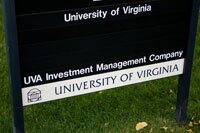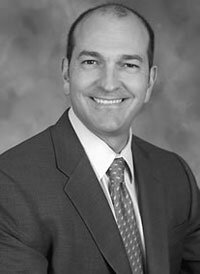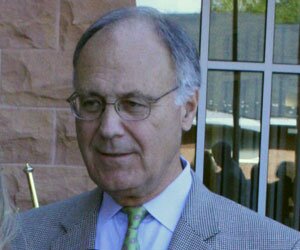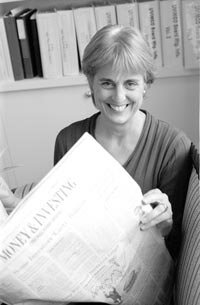COVER- Missing billion: how UVA's investment strategy worked... until it didn't

UVA's endowment and its mostly stellar investment performance is handled by a separate foundation– the University Investment Management Corporation.
PHOTO BY WILL WALKER

UVA has "ample liquidity" to meet all commitments, says UVIMCO CEO Chris Brightman.
PUBLICITY PHOTO

Despite a $10 million budget cut from the state and an endowment that's nearly $1 billion lighter, UVA President John Casteen assures employees, "Layoffs are not a strategy for us now."
PHOTO BY LINDSAY BARNES

Former UVA treasurer Alice Handy is widely credited with putting UVA's endowment in the top five of public universities.
FILE PHOTO BY JEN FARIELLO
The University of Virginia has long been distinguished as a "public Ivy" comparable to pricey private colleges of the Northeast. Now, in this era of financial meltdown, UVA is being lumped with the Ivy League in a less flattering way: for using an aggressive investment strategy called the "Yale model" that veers away from traditional investments like bonds into the more profitable– and riskier– world of private equity and hedge funds.
And, unfortunately, nearly a billion dollars just disappeared.
The University of Virginia's long-term investment pool was $5.1 billion June 30. By October 31, it sank to $4.2 billion, and its managers warn that it could go lower. But no one really knows what it's worth because, it turns out, more than half its investments lie in the little-understood worlds of hedge funds and something called "private equity."
A risky 'fetish'?
Wachovia and General Motors have each lost over $20 billion this year, and the U.S. Congress is offering financial companies $700 billion. With so many billions tossed around like confetti, why should anyone fret over the loss of just one billion at the college that Thomas Jefferson built?
For starters, a billion is nearly 20 percent of UVA's endowment, and it's a third of the current capital campaign. And as the #1 economic engine of a bucolic Piedmont city, UVA is the proverbial elephant in the room.
Already, scholarship athletes have been told they may have to pay for their own summer school, an unknown number of open positions will go unfilled, and UVA employees have been informed that their expected two percent salary increases have been frozen, with no unfreeze in sight this year.
While UVA's Chief Operating Officer Leonard Sandridge and President John Casteen assure the university community that all is well, what's happening to its investment pool has already caught the attention of some of America's top investors.
The head of private banking at New York investment giant J.P. Morgan blasts UVA and other colleges for their "fetish" for risky investments. In his November 10 Eye on the Market newsletter, Morgan's Michael Cembalast, excoriates UVA for putting over half of its investments in highly illiquid instruments.
What's worse, Cembalast says, is that UVA has begun to explore selling such already-hammered investments in order to meet cash calls– such a recipe for losing money that others have taken notice.
"UVA may win the prize for the most wholesale destruction of alumni gifts," writes financial blogger Henry Blodget on Clusterstock.com. "Sorry, UVA alumni," Blodget continues, "you're going to have to make those gifts all over again."
Such allegations sent UVA's top brass into damage-control mode. On November 13, Sandridge sent an open letter denouncing the reports, which, he alleges, "have misinterpreted the status of our endowment and in some cases declared us to be in 'distress.' These accounts," Sandridge wrote, in an attempt to mollify employees, students, and donors, "are simply inaccurate."
But are they?
UVA's own literature concedes that the university is so cash-strapped that despite recently borrowing $450 million, it is now planning to sell $400 million in already-depressed stocks to cover its obligations. Moreover, UVA's own investment reports show an investment pool in which stocks, bonds, and cash combine to less than half what's been invested in illiquid instruments like hedge funds and private equity.
Still, Sandridge reassures employees that the endowment "has sufficient liquid assets to cover its obligations," which he estimates to be between $700 million to $1 billion over the next three years.
What is private equity?
At the center of the storm is something called private equity. Here's how it works.
Private equity firms gather multi-year commitments from large institutions– such as university endowments and pension funds– into pools, which then provide the capital for dozens of startups, mergers, and other non-publicly traded companies. (Chrysler, for example, is owned by a private equity firm.)
"Private equity is like buying and planting an apple sapling," explains Charlottesville financial adviser David Marotta. "You don't get apples for a long time; and you have to water, fertilize, and prune them for many years."
Public equity, by contrast, is simply stocks, and they "are like an established orchard," says Marotta. "UVA owns both, and both of them have been hurt by frost."
The bigger problem comes when someone wants to harvest the private equity apples before the tree is ready, and that's what's happening now at UVA, which has commitments to private equity pools.
With private equity, the money doesn't get invested until the firms identify the deals they want to fund. But now that there's a credit crisis, private equity firms are clamoring to receive most if not all of the outstanding commitments. And UVA made a lot of commitments.
It's got $1.6 billion invested in private equity funds, and $1.8 billion in uncalled commitments. And UVA's top investment manager has begun telling people that he's interested in selling some of these positions on the secondary markets.
But J.P. Morgan's Cembalast points out that the secondary market "only exists in the narrowest sense of the word." Not only, he notes ominously, are there very few investors in the secondary market, but they all want "very steep discounts."
And while UVA allowed private equity to climb to approximately 20 percent of its holdings, Cembalast says he advises his clients to keep no more than eight percent of their portfolio in private equity.
"This," Cembalast says in his newsletter, "provides the flexibility to respond to changing market conditions, which over-extended endowments may not be able to do."
"When you invest in private equity," explains professor Susan Chaplinsky at UVA's Darden School of Business, "you make a commitment to fund Blackstone or the Carlyle Group." She uses an example in which an investor pledges $200 million to a private equity firm.
"If they don't have an immediate option, the money stays there," says Chaplinsky. "Maybe the first year, $50 million gets called, and $150 million goes uncalled." However, the investor remains on the hook for the remaining $150 million.
In UVA's case, $150 million would be a dream come true. In actuality, its uncalled commitment is $1.8 billion.
Getting rid of a $1.8 billion obligation
Financial experts say that UVA has four ways to deal with its looming $1.8 billion commitments:
• borrow money
• sell assets
• sell the positions on the secondary market
• lose half of the public equity money it's already handed over
Borrowing has already begun. UVA documents show that it has borrowed $450 million since its last June 30 annual filing. Short-term borrowing is a normal part of the management of cash and bond portfolios, contends the university's investment arm, and all short-term borrowing was repaid in early October.
Normally, capital calls are funded by distributions from other private funds. But the September 30 third-quarter report from the University of Virginia Investment Management Company notes that in recent quarters, distributions have been much lower, and "we should not expect any distributions this quarter and few in 2009."
As for selling assets, UVA may already be selling some battered investments, but the person with all the answers isn't talking. ("He has better things to do," says a UVA spokesperson.)
He is Chris Brightman, the CEO of UVIMCO, and while he did not respond to repeated requests for comment from the Hook, the university put together its own Q&A with Brightman in which he downplays any crisis.
"An unfunded commitment is not an unmet commitment," says Brightman. "Under every scenario we have considered, we have ample liquidity to meet all commitments, including spending distributions to the University, with a comfortable margin of safety."
Whew, that's a relief.
Yet Brightman's Q&A admits he plans to sell $400 million in stock to meet capital calls.
"They have to sell some of the public equities to take care of the saplings with no return," says Marotta, who says he understands the private equity allure: market-beating returns.
"Investing like the Yale endowment, in the mean, they will do better," says Marotta. "Ninety-nine percent do, but one time you go broke."
Marotta isn't a fan of private equity. At his wealth management fund, he says, "We do not invest in things that are not liquid. The normal investor needs to have access to his funds."
And UVA numbers show that 19.7 percent of its current pool is sitting in private equity, not to mention the uncalled amount.
"It's a lot to be illiquid," says Marotta, "for an endowment that needs to make contributions to the university's operating budget."
Last month, the university took a $10.6 million mandatory budget cut from the state.
"This is a year the university could use extra funds from the endowment," says Marotta. "Endowments are supposed to help you through hard times."
Who is UVIMCO?
UVIMCO is a separate UVA foundation with its own board, its own tax returns, its own employees. And its own growth in spending. From a budget of $814,000 in 1998, UVIMCO's spending skyrocketed to $7.6 million in 2007. The money goes mostly to salaries for a team of experts to manage the investment pool.
In 2006, for instance, CEO Brightman was earning $1.3 million, and six deputies were making annual salaries of $248,000 to $380,000, plus benefit packages of up to $69,000 per person. And yet, the group's performance really does appear to be Wall Street caliber.
Earning an average return of 12 percent annually over 10 years, UVIMCO hasn't just beaten the Standard & Poor's 500; it's demolished it. As President John Casteen would point out, the return in the S&P 500 over 10 years is zero.
In other words, a billion dollars put in the S&P 500 would still be worth a billion dollars. But a billion dollars placed with UVIMCO ten years ago, earning an average 12 percent and compounding its gains, would have more than tripled to $3 billion dollars.
Another feather in UVIMCO's cap is its low cost compared to the size of its investment pool. Despite those stellar-for-Charlottesville salaries, UVIMCO's spending amounts to just two tenths of a percent of the pool. And that looks positively spartan compared to, say, Harvard, which, in 2003, stunned the higher education world by paying its top six investments managers a combined $107.5 million.
By contrast, UVIMCO's entire spending that year– including salaries, benefits, travel, and even office rent– was just $4.3 million.
Still, Harvard got the more impressive returns– about 15.2 percent annually in the 10 years that ended in June 2006. The median return during that time for endowments and foundations was 8.9 percent, according to Wilshire Trust Universe Comparison Service.
One difference between Harvard and UVA is that Harvard runs many of its own funds, thus saving itself the steep cuts from hedge fund managers right from the start. UVA's team simply hires an array of outside funds and managers, each of which takes its own fee before turning over the net proceeds to UVA.
Change in strategy
In the early 1970s, UVA's Board of Visitors decided to commit to a "then unconventionally high" 75 percent of its endowment assets in domestic equities and 25 percent in bonds, according to a 1999 report by President Casteen.
The report boasts that UVA's endowment had reached $1.2 billion and consistently ranked among the five largest public institutions and among the 30 largest of all colleges and universities in the country.
In 1998, the Board of Visitors formed UVIMCO, headed by UVA treasurer Alice Handy, who has been widely credited with the endowment's market-beating performance. In the fiscal year 2000, for instance, when the S&P rose six percent, Handy delivered an eye-popping gain of 43.8 percent.
"To be in this business, you have to be willing to take risks," Handy, who declined to comment for this article, told the Hook back in 2003.
In 1999, UVIMCO upped its equity allocation from 75 to 80 percent, and made the decision, the Casteen report says, to make investments that are "more inefficient and less liquid in order to capture the return premium offered."
Stocks were 20 percent of the picture. Private equity was now 35 percent of UVA's equity pool, and a relatively new creature– hedge funds– got 25 percent of UVA's money.
Another big-boy investment, hedge funds are unregulated investment pools whose managers typically charge what's called "2 and 20." That's an annual fee of two percent of the total investment, as well as 20 percent of the gains.
Handy liked them because, she said in 2003, "We can short stocks and go long."
Eyebrows rose, but Handy continued delivering market-smashing returns. She left UVA that year to form her own company, Investure, to invest money for smaller colleges that didn't have their own endowment offices.
"I do not believe they've been imprudent," says Mark Giles. The founding president of Virginia National Bank and a UVA donor, Giles says that even the recent stock market crash has validated UVA's strategy.
"It's not going to stop me from making contributions," says Giles. "If they'd been in plain-vanilla blue chip investments, they'd have gotten killed."
Casteen gets involved
Yale first started this trend of non-traditional investments under the theory that universities have a long time horizon, so why should they be stuck in traditional, low-performing, liquid investments like bonds and government notes? And there was another, more local, reason for UVA to consider such a strategy shift. State support of Virginia's flagship university had steadily declined, from nearly 30 percent in the 1980s to about eight percent today.
With his decision now under fire for letting UVIMCO assume a more aggressive posture, Casteen leapt back into the fray a day after Sandridge. On Friday, November 14, he sent an open letter promising to respond to what he called "generally mistaken" coverage.
Although he didn't actually name any coverage errors, he relates two prior panics. During the 1987 stock market crash, Casteen notes, the UVA endowment dropped 12.2 percent in the fourth quarter but closed out the fiscal year at no loss. Three-and-a-half years later, during the first Gulf War, the endowment lost 10.2 percent in the third quarter but finished the 1991 fiscal year 1991 at with an 8 percent gain.
"Our endowment bounced back from those losses," says Casteen. "It will bounce back from these current losses."
But how long will that take?
One shocker this time is that UVIMCO admits that it's so cash-strapped that it's now planning to sell assets like stocks and hedge funds– not to mention it may market older private equity stakes.
That's what many financial professionals call "locking in your losses," and it indicates that UVIMCO wasn't liquid enough to simply hold on for a long-term rebound. Casteen doesn't address this in his letter, nor would he grant an interview.
This isn't the only area where Casteen's investment strategies have brought him unwanted attention.
In late September, when hundreds of Charlottesvillians saw their holdings in Wachovia, which took over homegrown Jefferson National Bank in a 1997 stock swap, nearly wiped out, the Hook approached Casteen at a dormitory ribbon-cutting.
"It's sad," said Casteen. Pressed for more, Casteen– who earns $220,000 annually for his part-time work as a Wachovia director– was whisked away by a handler.
Now that the financial crisis has struck his full-time job (where he makes a reported $797,048), however, Casteen appears more involved.
His open letter to the community talks of recent UVA borrowing as a good thing– because it affirms the University's AAA bond rating. And he notes that the Board of Visitors is sticking by its June decision to spend five percent of the endowment– $161 million– on operations instead of the usual 4.5 percent.
"Our schools and departments," he claims, "will have more resources at their immediate disposal for the remainder of this year than they had before the state cuts."
Still, that's little consolation for faculty and staff who were expecting a two percent salary hike on November 25. At least there's this: "We have never used layoffs here as a means to balance budgets," he writes. "Layoffs are not a strategy for us now. We are cutting expenditures in many areas throughout the University."
And while donations have slowed, Casteen notes that they have added $150 million to the university's long-term pool since July 1. And even after the post-June turmoil, including the financial bloodbath of September and October, UVA reports claim its endowment has lost just 18 percent. The S&P lost over 24 percent.
Tumultuous
Clearly, these are not normal times when, in one day, the stock market's bellwether, the Dow Jones Industrial Average, swings down 500 points, then up 900. And it has continued to fluctuate wildly nearly every day for the past two months.
"Any time your portfolio goes down is cause for concern," says S. Buford Scott, chairman of venerable Richmond brokerage Scott & Stringfellow and a former member of the Board of Visitors. "These times are the most unusual I've ever seen in 50 years."
He notes that UVA isn't alone in trying to unload some of its commitments.
"Several large university endowments are trying to sell private equities," says Scott. "There are lots of sellers and few buyers."
He suggests UVIMCO may have to tough it out. "UVIMCO has done a wonderful job," he says. "This is something they'll have to live through."
"Are they experiencing tough times?" asks Darden's Chaplinsky. "Yes. Can you point to someone not experiencing that now?"
In the current "unprecedented" market turmoil, "I don't think there's a single class of investment that's not experiencing stress," she says.
The problem for private equity capital calls: "Anytime you have to sell in a market like this that's stressed, there's going to be fallout," says Chaplinsky.
She does see a bright side to getting capital calls.
"Private equity investors are seeing opportunities right now, really good opportunities to put money to work at very attractive prices. What you have here is a timing problem."
The problem, in other words, is that UVA might be selling private equity when now appears like the time to buy.
Brightman admits that illiquidity is forcing his hand in a recent UVIMCO report. "If markets continue to fall," says his report, "we may need to sell more liquid securities and redeem more from hedge funds."
But officials dispute the notion of any fire sale.
"We are not a distressed seller," says UVA spokesperson Carol Wood. "We may sell some things to go buy other things. If we don't get the price we want, we're not going to take just anything."
As for critics who question whether UVA's endowment should have ever been in riskier markets, Chaplinsky points to the state's ever-shrinking funding.
"I don't think the university wants to be in high risk investments, but risk is a corollary of return," she says.
"Funding needs to grow six, seven, eight percent," says Chaplinsky. "If you want to be safe, you could be in Treasury bonds at one, two, or three percent."
#